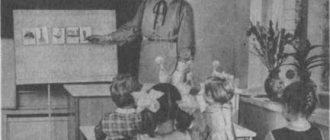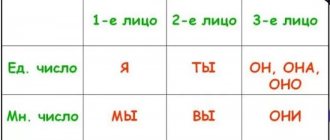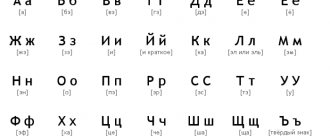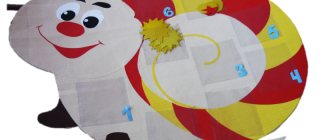Phonetics terms and groups
Science has come far in the study of the Russian language. Special emphasis was placed on the section of phonetics - the study of the written representation of sounds. Experts collected statistics on the sonority of human language:
- On average, a person produces a couple of hundred sounds in one day.
- They use more than 50 sounds to express their thoughts.
- However, only 33 of their designations are used in the letter.
The two main tools of phonetics are letters and sounds . It is important to know the features of each group and their differences:
- An element that is used only for written display and reading is a letter.
- An element that is only spoken and listened to is sound.
The difficulty of parsing is that the pronunciation of a word can differ significantly from its spelling. For example, the number of one of the groups of elements (letters or sounds) may be more/less than another. Otherwise, the quantity may remain the same, but the written display will not match the audible one. This is due to the rules of spelling and spelling.
However, phonetics only includes aspects of pronunciation . These include:
- sound;
- letter;
- accent;
- syllable.
All of the above terms have individual properties, but together they form a characteristic of the sound of a word - phonetic analysis.
Recommendations for developing a child’s correct speech
We have already mentioned that the development of a child’s pronunciation and his speech in general depends on his physical condition and the environment in which he develops, so your actions towards the baby directly affect the development of his speech. What points should be taken into account?
Be attentive to your child's health
Take care of your baby’s health, monitor his physical activity, keep a diary of observations of your child and make all changes in it: he began to cry more often, ate less, slept longer than usual, began to smile at his parents, etc. Regularly share your observations with your pediatrician and try to follow his recommendations. Remember that frequent illnesses and neurological disorders can affect the baby’s speech development.
Monitor your baby's surroundings
Don’t let your family distort your speech when communicating with your child, the phrase “Who’s so screwed up here and is looking at the folnyfko?” will not benefit the child’s emotional or speech development. Also, carefully monitor the speech of the specialists who work with the baby: do not doubt that in just a month the baby will perfectly master all the features of his nanny’s speech. If your loved ones have problems with sound pronunciation, then you should contact a speech therapist and get recommendations on how to prevent your child from acquiring similar problems.
Talk to your child
You need to talk to your child, pronouncing words clearly and without distorting them, from birth. Train yourself to say as much as possible what is happening around you while you are with your baby: “A car is driving past. The car is big red, but there is a small yellow one standing there. We go to the stop and take the bus. Vanya likes to ride the bus? When your baby asks for something, be sure to talk to him about what kind of item he wanted: “Do you want an apple? Look what an apple. Tasty apple. Now mom will cut Vanya an apple.” When you name objects and use verbs and adjectives in your speech, the child’s speech (as well as memory, attention and thinking) is enriched.
Visit interesting places
Interesting events stimulate the child to talk. The baby will be happy to talk if he is interested. Go to museums, parks, zoos and botanical gardens together; even watching a train on a railway bridge can become a whole event in a child’s life. A change of environment incredibly develops a child’s vocabulary, because where, if not in a zoo, will a child understand what a crocodile is and what a stork really looks like.
Spend time developing fine motor skills
The human brain is designed in such a way that speech does not develop without the development of fine hand movements: modeling, drawing, appliqué, sorting out cereals and packing small objects are just a small part of the activities in which fine motor skills are involved. Try to regularly include such activities in your baby's daily routine.
Use special games to develop speech
Pure twisters (repeated syllables that rhyme with a subsequent sentence, for example, “Mar-mar-mar, there’s a mosquito on your nose!”), tongue twisters and games for the development of phonemic awareness can be used at home and on a walk, in line to the pediatrician and on the train to the country. Repeat syllables with different intonations and voices of different characters, ask the child to do something (clap, stomp, sneeze) when he hears a certain sound in the words you pronounce, ask him to find an object around that is denoted by a word with the desired sound or syllable.
The development of correct sound pronunciation does not require special and long-term activities: it is enough to communicate regularly with the baby, be attentive to his health and fill his life with interesting events. In any daily routine, you can also find 5-10 minutes for games to develop speech and phonemic awareness.
Features of parsing
The most common situation in which mistakes are made is when the sound and the written symbol do not match each other. If spelling is responsible for the correct spelling, then phonetics regulates the rules of pronunciation of words. To successfully complete audio analysis, it is recommended to consider a few tips:
- Accurately establish all the features of the sound of a word.
- Make your own transcription for each letter.
- Under no circumstances should sounds and letters be adjusted to match each other. For example, shi [shi] - cars.
- After completion, pronounce the word out loud clearly and carefully again, checking each unit of speech.
There is a special algorithm for phonetic parsing. Some information is required to be memorized, the rest is recommended to be written down in the form of a memo. The main rules in phonetic analysis within the school curriculum:
- Voiced consonants at the end of a word become voiceless. For example, oak [p].
- Hard consonants become soft if they are followed by soft consonants. For example, here [z'd'es']. This mainly happens with the letters: z/s, d/t, n.
- Voiced consonants become voiceless if they are followed by a voiceless consonant. For example, rarely [p 'etk a].
- Deaf people are transformed into voiced ones if they stand in front of the same voiced ones. For example, pass [zdat '] sample.
For students of higher educational institutions with a philological profile, the rules are somewhat larger. They additionally study:
- accommodation;
- dissimilation;
- reduction.
These three points are studied for a deeper understanding of phonetics and how speech norms are transformed. They will also help students who want to teach in the future to explain complex topics more clearly and quickly and analyze common mistakes of their students.
Classification of sounds
In turn, sounds are also sorted into two groups. Their main difference from each other is the anatomy of formation. What classes exist:
- Consonants. When pronouncing them, a person faces obstacles. The barrier is one organ or a whole group of them (lips, teeth or tongue).
- Vowels. With the help of the larynx and individual parts of the oral cavity, air leaves the lungs without any interference - this is how a vowel sound is formed.
To understand the remaining differences, it is necessary to analyze each concept in detail.
Types of vowels
In total, there are 6 vowel sounds in the Russian language (o, i, a, e, ы, u), but up to 10 letters are used to denote them in writing. This is due to the fact that some of the vowels can have several letter designations at the same time. For example, there is a semivowel “th”. It is worth considering that in the school curriculum it will be indicated by a consonant sound. Also, its purpose is to display additional vowels (I, e/e, yu). In phonetic analysis it will look like:
- I - [ya];
- e - [ye];
- yu - [yu];
- ё - [yo].
However, these vowels will not always appear as two letter elements in the diagram. The rule holds only in certain conditions:
- At the beginning of the word. (Yana, January).
- After vowel sounds (safe haven, young mother, high-speed train).
- After the hard/soft sign (enter the house).
Otherwise, these vowels will soften, but they will not give a double sound together with “y” (guys, wind).
All vowels are further divided into two subgroups, depending on the sound in front of them. These include:
- If there is a hard consonant (cup, forty). This group includes: a/o, u, e, s.
- If a soft consonant is indicated in front (saw, feather). These include: i, e/e, i/e.
Each vowel also has its own personal characteristic - stress. It must be indicated in the phonetic analysis. According to this feature, a vowel can be either stressed or unstressed. The stressed sound is always written and pronounced the same way (Moscow - under the accent “a”).
Consonant clusters
There are significantly more consonant sounds than vowels. There are 20 of them in total. They are also divided into groups according to certain characteristics. In this case, consonants can simultaneously appear in several groups, that is, have several characteristics:
- Voiced: b, v, d, d, g, z, r, l, n, m.
- Voiceless: p, f, k, t, sh, s, x, c, h, shch.
- Pairs: b/p, h/f, g/c, d/t, w/w, s/s.
- Unpaired, but they are divided into 2 more subgroups. Voiced: r, l, n, m. Voiceless: x, c, ch, shch.
- Hissing: zh, h, sh, shch. All others can be classified as soft or hard.
- Hard: f, w, c. Their softness does not change in any situation.
- Also unchanged soft: th, ch, shch.
During pronunciation, problems may arise with the correct determination of voicedness, since both deaf and voiced have the same articulation (cactus). There are two methods for solving the paired consonant problem:
- Divide the alphabet into two parts. The voiced consonants will come first, followed by the voiceless ones.
- Study the rules for the positions of consonants, at which they necessarily become voiced/voiceless.
conclusions
Children master the sounds of their native language throughout preschool age. Together with the first words, the simplest sounds are pronounced, and over time, when the articulatory apparatus is already sufficiently developed, the child begins to pronounce complex consonants, for example, [p] or [z]. The entire process of mastering sounds, from infant humming to fully developed pronunciation, can take 5-6.5 years. An organized environment and parental attention contribute to the development of correct speech in the child, and regular consultations with a speech therapist and pediatrician will help prevent speech disorders in the baby.
Schematic model
During phonetic analysis, a schematic representation of the word is compiled. In fact, this is a diagram in the form of color cards of different shapes. Sound analysis of a word and diagram for preschoolers is an example that helps create an image for perceiving and understanding the details of the structure of a word. There are only two shapes - rectangular or square. But there are many color differences:
- The square blue card is a hard consonant.
- A green card in the shape of a square is a soft consonant sound.
- A square in red is a vowel sound.
- Two triangles (blue and red) connected into one rectangle - a syllable consisting of a hard consonant and a vowel.
- A red and green triangle, which are connected into 1 rectangle - a syllable consisting of a soft consonant and vowel sounds.
The sound patterns of words in grade 1 (cards) have their exact sequence in color and shape. If you use this method correctly, learning will be quick and easy.
They use sound analysis of words in 1st grade (diagrams and analysis) and preschool education, as an auxiliary tool in teaching reading. The teacher will not only be able to talk about each unit of speech separately, but will teach how to put them together and separate them again. In addition, the model highlights the difference in pronunciation between consonants and vowels.
Sound analytical-synthetic method of teaching literacy
In modern schools, the sound analytical-synthetic method of teaching literacy has been adopted. First-graders, in their mental development, are ready for both the perception of individual sounds and such mental operations as analysis and synthesis.
During the period of learning to read and write, much attention is paid to the development of phonemic hearing, that is, the ability to distinguish individual sounds in a speech stream, to isolate sounds from words and from syllables. Students must “recognize” phonemes not only in strong, but also in weak positions, and distinguish between phoneme sound variations. This, in turn, allows you to develop spelling vigilance, which is necessary for the successful development of literate writing.
In elementary school, an analytical-synthetic method of teaching literacy is used, implemented by the following techniques: sound analysis of a word, syllabic-sound analysis of a word, sound-letter analysis, sound synthesis, syllabic synthesis.
K. D. Ushinsky also spoke about sound analysis for the purpose of teaching literacy. Research by physiologists and psychologists allows us to talk about analysis and synthesis as related, but different in structure, mental actions. D. B. Elkonin considered sound analysis as an analysis of the sound structure of words. One of the most important provisions of teaching literacy according to the D.B. Elkonin is the formation in children of the action of sound (phonemic) analysis of a word before becoming familiar with letters. D. B. Elkonin characterized this action as repeated pronunciation of a word with intonational emphasis (drawing out, “emphasizing” with the power of the voice) of each subsequent sound. Using specially selected words, the sound structure of which gradually becomes more complex, based on diagrams-models of words in the form of sequentially located cells and with the help of chips in which sounds are materialized (“reified”), children learn to establish the number and order of sounds in words and characterize them .
This is what the first stage of teaching literacy using D. B. Elkonin’s ABC book is dedicated to. In its original form, phonemic analysis is the establishment of the sequence of phonemes (sounds) in a complete word. Mastering the method of phonemic analysis is associated with a number of difficulties. Unlike the natural (intuitive) division of a word into syllables, the division of a word into sounds must be specially taught. As a rule, before learning to read and write, a child knows about the existence of letters; sounds are generally absent in the child’s mind and do not exist for him. Phonemic analysis, that is, the ability to isolate a sound sequence from a word, becomes a method of action if, from the very beginning of its formation, it develops purposefully and consciously: the student not only masters a certain sequence of operations, but also acquires the ability to control and evaluate his actions. The correctness of isolating each subsequent sound of a word is most effectively controlled in a complete word. There is a natural connection between the sound of a word and its lexical meaning in a language. Any violation of one of the elements of this interconnected integrity leads to a distortion of the “sound portrait” of the word.
Syllable-sound analysis of words
, syllable-sound analysis has acquired priority in teaching literacy . The term “syllable-sound analysis” was introduced by V. G. Goretsky, V. A. Kiryushkin and A. F. Shanko, who developed a stable “Primer” and methodological recommendations for it. The introduction of the term is associated with increased attention to syllabic work, especially with the syllable consonant + vowel
(SG), which is called “merger” in the manuals of these authors. The teacher draws the children's attention to the fact that in a syllable of type SG two sounds are closely related to each other: they seem to merge together and therefore are pronounced at once, without stopping, inseparably from each other (sound synthesis occurs). The designation of such a merger of a consonant with a vowel is given in the model diagram:
[C] → [A] → → [SA] → - “superposition” of the articulation of a vowel sound on the articulation of a consonant (syllable type SG).
Syllable-sound analysis when teaching using the new “Primer” is, according to V. G. Goretsky, a means of penetrating the phonetic structure of a word and is the most important component of all work in literacy lessons. “The existing feature of syllable-sound analysis of words, which is an indispensable component of work in lessons in teaching reading and writing, is not only to establish the number and sequence of sounds, as is usually the case, but also to determine the nature of the connection between them” (V. G. Goretsky).
In-depth work on the sound composition of a word subsequently leads students to a clearer correlation between sound and letter and prevents their confusion. The authors of the method recommend syllabic synthesis when reading a word, which goes in parallel with syllable-sound analysis. For example, to read the word table,
The fusion syllable (SG) should be highlighted first: [to], then the syllable is closed [l] - [tol], and then first pronounced [s] and the already identified [tol] - [table] is added.
Sound-letter analysis of words
Sound-letter analysis of words has long been considered in our school the main type of sound analysis in teaching literacy. However, methodologist P.S. Zhedek emphasizes that the most persistent and intractable errors are errors when performing tasks for sound-letter analysis of words: “...students, having received a task for sound analysis, actually analyzed the letter composition of the word, relying on its visual representation.” The reason for the persistence of the error, according to P. S. Zhedek, is the result of replacing the analysis of the sound envelope of a word with reasoning about the sound meanings of letters. Sound analysis, which is carried out with a focus on the letter without listening to the word, is the cause of phonetic errors in children. P. S. Zhedek believes that it is necessary to distinguish the actual sound analysis, which is given time in the pre-letter period, from the sound-letter analysis, which is the leading technique in the main (letter) period of learning to read and write. Moreover, sound analysis itself, as an exercise for the formation of phonemic hearing, must be carried out throughout the entire period of study in primary school, and not just in the preliterary period. Working with the sound structure of a word is a propaedeutic of spelling skills, as it forms the student’s spelling vigilance.
What is the difference between sound-letter analysis and sound analysis itself?
Let's analyze the plan for sound-letter analysis of words.
1. How much is in the word apple
syllables, which syllable is stressed?
2. How many sounds and letters are there in the word?
3. How many vowels are there in a word? How many consonants?
4. Describe each sound. What letter is it indicated on the letter?
It can be seen that already in the plan of sound-letter analysis there is an orientation towards the letter, and not towards the sound: asking questions at the second and third steps of the plan encourages one to operate with letters, and not with sounds. The purpose of sound analysis itself is to highlight successive units in a sounding word. This type of parsing does not require reference to the letter.
P. S. Zhedek believes that when moving to a higher level of sound analysis, it is necessary to expand the range of words being analyzed. First, use words in which, if there are phonemes in weak positions, they coincide with the main type of phonemes (with a strong position), for example: word forms legs, water
.
At the next stage, parse words that contain sounds that do not coincide acoustically with a strong position, for example: word forms: leg, water, legs, water
.
Thus, when moving to a new stage of sound analysis, the need arises to discuss the spelling of these words, that is, to include this analysis in the sound-letter analysis. In order for the actual sound analysis to truly constitute the initial stage of the sound-letter analysis, to be included in it, it is necessary to preserve the already established order of the actual sound analysis of the word, supplementing it with one more point: what letter each sound is denoted and why.
With this analysis of words, the student explains the choice of letters not simultaneously with the selection of sounds, but only after the sound analysis has already been completely completed. In this way, the sound analysis proposed by P. S. Zhedek differs from the traditional sound-letter analysis, in which, when analyzing the sound composition of a word, orientation towards the letter is possible, which can negatively affect the development of the ability to hear and correctly characterize sounds.
Into the methodological piggy bank.
To conduct sound analysis, various gaming techniques are used that create motivation for articulatory actions and the development of phonemic hearing.
1. When introducing students to a new consonant sound, you should come up with an image that will allow them to practice its correct articulation, for example: “What sound does a tiger make when it’s angry? - [r-r-r-r-r]”, “How does the wind rustle in the leaves of the trees?” - [sh-sh-sh-sh-sh-sh-sh-sh-sh]”, “How does a mosquito ring above your ear? - [z-z-z-z-z-z]”, etc.
2. Introducing the students to the new letter of the consonant sound, we play the game “Soft - Hard”: “With the fingers of one hand, we touch the tips of the fingers of the other hand: on top the nails are hard, and on the bottom the pads are soft. Now, together with me, we pronounce sounds and touch either from above - where the marigolds are, or from below - where the pads are, depending on what sound - hard or soft - I pronounce.” The teacher makes a hard sound and touches the marigolds, and the children repeat after him: [s-s-s-s-s] - and tap the nails - “hard”, [s'-s'-s'-s'-s '] - on the pads - “soft”. Tactile sensations reinforce the understanding of hardness and softness of consonant sounds.
3. Introducing children to the pairing of voiced - deaf consonants, we play “voice”: we pronounce alternately deaf and voiced consonant sounds and observe what appears and disappears, we draw the conclusion - voice. Voiceless sounds can be pronounced in a whisper, but voiced sounds can only be pronounced loudly; without a voice, voiced sounds turn into dull sounds; we continue the game: the teacher asks you to put your hand on your throat and pronounce the voiceless sounds [s], [s'], [k], [k'], [sh], [ch'], and then the voiced sounds [z], [z'] ], [g], [g'], [f], [l]', asks how the throat behaves. The children alternately pronounce after the teacher either the voiceless “neck is sleeping” or the voiced “neck is waking up.” We conclude: when we pronounce a dull sound, “there is no need for a voice,” when we pronounce a voiced sound, “the voice runs, but the throat trembles.” We reinforce with the game “Soft - hard, dull - sonorous”. The teacher pronounces the sounds, and the children guess their “character” by saying after the teacher and helping with their hands: [t-t-t-t-t] - marigolds? Pads? - Nails! - hard, hand on the neck - asleep? trembling? - “sleeping” - deaf; [s'-s'-s'-s'-s'] - “marigolds?” “pads!” - soft, voice “is he sleeping? trembling? - “sleeping” - deaf, etc.
4. Game “Mirror”: pronouncing sounds, compare them, look in the mirror and discover how the sound is formed. For example, we observe the pronunciation of vowels: we say it while looking in the mirror: not a single sound has an obstacle, then why do they sound different? It turns out that the lips and tongue take different positions. We observe the pronunciation of consonants, for example: [s] / [z] - the language puts the barrier in the same way for both sounds, but why are they different? We check the nails, the pads - “equally hard”, we check “is the little voice sleeping? trembling? This is where the difference is: [s] - “sleeping”, which means deaf, [h] - “trembling”, which means voiced.
A variety of techniques allows children to master many complex skills of sound analysis and synthesis in a relaxed atmosphere. Often teachers independently come up with game techniques, adapting complex phonemic material in different ways in accordance with the specifics of their class. This work is also necessary because first-graders often have speech therapy problems, which, thanks to many of the above techniques, can be overcome without special help.
Warehouse method by N. A. Zaitsev
“Zaitsev’s Cubes” is a practical implementation of the ideas of the founder of Russian physiology I.M. Sechenov. The flow of sensations passing through a growing organism is clearly divided into unique “quanta of information” (according to N.A. Zaitsev), operations with them are accompanied by rhythmic movements with periodic motor-emotional accents. “I see, I hear, I touch” are the main guidelines of the method. Each cube reproduces combinations of one consonant with all vowels of either the upper or lower row (along the “ribbon of sounds and letters”): for example, on one of the six sides of a large cube you can read NA - NO - NY - NE - NU - N, and a small one cube - NYA - NOT - NI - NOT - NU - NY. The cubes, which depict all possible syllable combinations in the Russian language, are of different sizes and have different sounds. 1) Cubes with fusion syllables that have a hard consonant are larger in size than cubes with syllables that have a soft consonant. This is explained by the peculiarities of articulation: when pronouncing hard sounds, the oral cavity is more voluminous than when pronouncing soft consonants. Children, by singing or pronouncing sounds, syllables, words, learn to notice these facts. 2) The cubes with the letters of voiced consonants are filled with metal parts and, when you take them in your hand, they make a slight tinkling sound. The cubes with the letters of hard consonants are filled with wooden parts and “rustle”. Zaitsev's sounding cubes are a kind of “musical” instrument with which a child can independently develop word-forming creativity. Children trained using this method not only successfully master the skills of reading and writing, but are specially introduced to the sound reality of the language in such a way as to ensure the subsequent acquisition of grammar and associated spelling.
For the method of N.A. Zaitsev is characterized by such an important factor for a growing organism as the rhythm of activity. It manifests itself in the rhythmic presentation of sound stimuli by the teacher, and in the rhythmic motor responses of children, and in motor-emotional aspects dosed according to a certain rule, and in the rhythmic movements of the child’s hand to identify types of cubes. Rhythms, synchronizing neuropsychic processes, “swing” the brain and promote the necessary functional resonance, facilitating perception, activity and assimilation of knowledge and skills. Another important advantage of N.A.’s teaching methods. Zaitsev are the formation of correct posture, a high level of general motor activity, improved diction, correct gaze fixation and many more additional factors associated with the possibility of active emancipation of the child’s individual abilities.
Thus, the application of the methodology proposed by N.A. Zaitsev, meets the vital interests of the body of a small child, his biological needs aimed at understanding the world through play, movement, and the joy of successful competition. At all stages of learning to read, mental actions are formed in children (SEE: Zaitsev N.A. Writing. Reading. Counting. - M., 2003; Zaitsev N.A. I draw, read, write. Methods of N.A. Zaitsev. - St. Petersburg, 2003).
Cubes N.A. Zaitsev appeared as a result of the generalization of a number of techniques of innovative teachers (in particular, S.N. Lysenkova), based on the method of synthesis and comparison of a “tape of sounds and letters.” The most productive techniques for sound synthesis are reading tables and (or) filling them out. For example, when studying the letter m (em), a table of syllables with consonant sounds [m] and [m'] is reproduced:
| mm] | ma | mo | mu | meh | We |
| mm'] | me | me | mu | meh | mi |
As the studied letters of consonant sounds accumulate, the table increases:
| mm] | ma | mo | mu | meh | We |
| mm'] | me | me | mu | meh | mi |
| r - [r] | |||||
| p - [p'] | |||||
| d - [d] | |||||
| d - [d'] |
When introducing the study of a new letter in a lesson, it is advisable to read a table of syllables formed by letters of vowel sounds with the letter studied in the lesson. As the number of letters in the table increases, at the fastening stage, the technique of horizontal and vertical stripes should be used (strips are cut from cardboard according to the size of the column and the size of the horizontal column). Either a column is covered with a strip, and then the children independently reproduce the syllables of the closed column, focusing on the upper letter of the vowel and looking at the consonant sound indicated on the left; or the column opposite the letter of the consonant is closed, then the children are asked to pronounce the syllables independently, focusing on the letters of the vowel sound indicated in the upper column.
| [A] | [O] | [y] | [e] | [s] / [i] |
| [m] | ||||
| [m'] | ||||
| [d] | ||||
| [d'] | ||||
| [To] | ||||
| [To'] | ||||
| [l] | ||||
| [l'] |
To train the ability to add parallel sounds, another type of table is used, which increases the share of students’ independent participation in composing syllables for reading. The teacher is recommended to fill out only the left column with consonant sounds corresponding to the letters studied, and the top line with vowel sounds. Using a pointer, the teacher draws a line from consonant to vowel (and from vowel to consonant) and asks the student to name the syllable (at the intersection of the column and row). Then, in the empty cell, the students will independently write down the pronounced syllable. Example: merging syllable [la], syllable “with a lock” [al']. You can correlate the first syllable with the name of the note A, and the second with the form of the personal female name Al (Alya).
Any methods used in literacy lessons should be presented in a playful form to constantly maintain interest in learning the native language.
Phonetic parsing algorithm
When all the terms have been studied, the speech units have been sorted into groups, you can proceed directly to the phonetic analysis itself. All analysis results must be recorded. In appearance, it is similar to compiling a transcription when reading and pronouncing words from foreign languages.
To carry out the analysis correctly, you need to follow the algorithm. Procedure:
- Write down the selected word according to spelling rules.
- Select the main parts - syllables. For example, the alphabet is az-bu-ka.
- Determine which vowel is stressed. Ski - stressed sound "s".
- Make a diagram (transcription) of sounds. Play - [play'].
- Display a count of the number of letters and sounds in a word. Elena - 5 letters, 6 sounds.
The analysis can be written not only point by point, but also in the form of a column. In this case, each letter is written on a separate line and given its own characteristics.
Division into syllables
One of the parsing points is to divide the word into syllables. Syllables are the smallest unit of speech structure. There is a little trick: “to count the number of syllables in a word, you can simply count the vowel sounds.” For example, the word “aster” has only 1 syllable.
However, division is still subject to strict rules, which are not always consistent with the requirements of word hyphenation.
Initially, it is important to know that syllables have several varieties:
- Open - if it ends with a vowel sound.
- Closed - if there is a consonant at the end (notebook).
- Covered if there is a consonant sound at the beginning (sour). Therefore, if the vowel is open (window).
In addition to types, there are other parsing rules. What you need to know about syllables:
- A syllable must contain one vowel and one consonant sound. For example, rose (ro-za). Moreover, individual even important parts cannot be full-fledged syllables. For example, a prefix is not a syllable.
- In general, syllables begin with a consonant and must be followed by a vowel. A consonant sound by itself cannot form a syllable. For example, the word world has one syllable, not two.
- If a word has a soft/hard sign, it is part of the previous syllable. For example, driveway. In addition, a hard/soft sign cannot be a separate syllable. For example, seven is 1 syllable, boy is 2 syllables.
- Several letters that create one sound cannot be divided into different syllables. For example, spinning - spinning.
Like any other science, phonetics is constantly evolving. Therefore, the rules of phonetic parsing may change over time. Latest changes to the analysis:
- According to the old rules, double letters in a word were distributed over different syllables. Today it is customary to write them in the syllable that they begin. For example, cool.
- According to innovations, voiceless consonants are written in the syllable following them (dot: dot-chka). At this time, the voiced ones remain in the preceding syllable (strawberry: club-ni-ka).
Knowledge of phonetics not only gives spelling literacy. This science promotes the development of memory and phonetic hearing, teaches how to correctly and beautifully pronounce certain sounds, understanding the details of their composition. And if you can’t do the analysis yourself, you can do an audio analysis of the word online.
Why do sounds appear at different ages?
The development of a child’s speech requires the active inclusion of a huge number of different processes: the development of hearing and vision, memory, thinking, attention, training the muscles of the tongue and lips. Try pronouncing the sounds [a] and [r] and compare how much more control and skill the second sound requires, while the first is pronounced without complex movements of the tongue and lips. It is not surprising that the sound [r] can appear in a child several years after the appearance of speech, because it takes a lot of practice for the child to understand how to pronounce and use such a complex unit of speech.
Unfortunately, to produce complex sounds, some children may require the help of a specialist: anatomical features, unclear speech of the parents themselves, and other features of the child’s environment and development can lead to the fact that children need a special exercise program and supervision from a speech therapist and doctors.
The question arises, how to recognize whether a child needs a speech therapist to correct sound pronunciation or whether he just needs to read more and learn poetry? To do this, parents need to understand and analyze four things:
- General stages of development of sound pronunciation in children. For example, the sound [c] most likely will not appear before the sound [t], children under three years old can be forgiven for softening their consonants, and the sound [r] can only be formed by the age of five or six.
- Environment. When a child learns, he takes the speech of the people around him as a basis, so if dad “swallows” the endings of words, mom lisps, grandma burrs, and grandpa has a lisp, the child has every chance to collect a full bouquet of sound pronunciation disorders. It should also be remembered that babies born into bilingual families tend to mix the sounds of different languages.
- Health and anatomical features of the child. Birth injuries, hearing impairment, malocclusion, unusual structure of the palate, as well as general susceptibility to disease can become a serious obstacle to the development of speech and are often insurmountable without the support of specialists.
- Features of education. Children whose parents do not pay enough attention to their speech may get used to pronouncing sounds incorrectly, but those children who receive too many comments tend to simply skip complex sounds, trying not to run into criticism once again.
If a child has difficulties in one or more categories (for example, the baby is far behind age norms or is surrounded by adults with speech impediments), it is worth consulting with specialists and getting recommendations on the development of the baby’s speech and sound pronunciation.
Remember, any developmental disorders are corrected more easily and quickly if work begins immediately after their appearance, so you should not delay a visit to a children's speech therapist, psychologist or doctor if something worries you about the baby's development.






